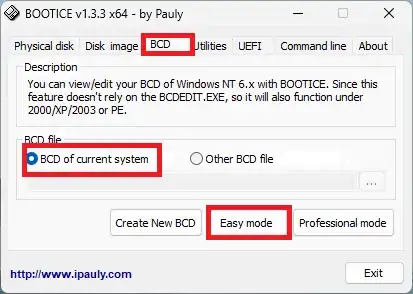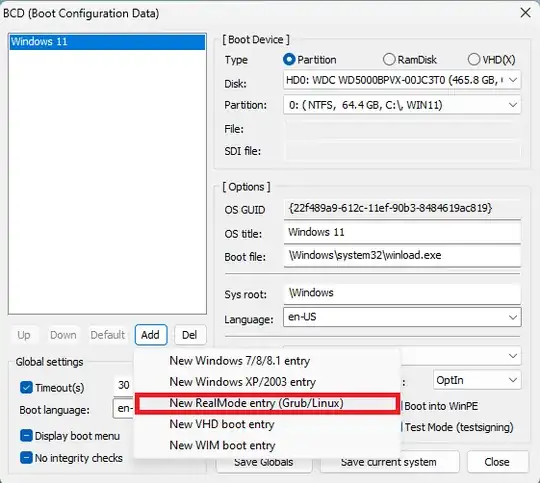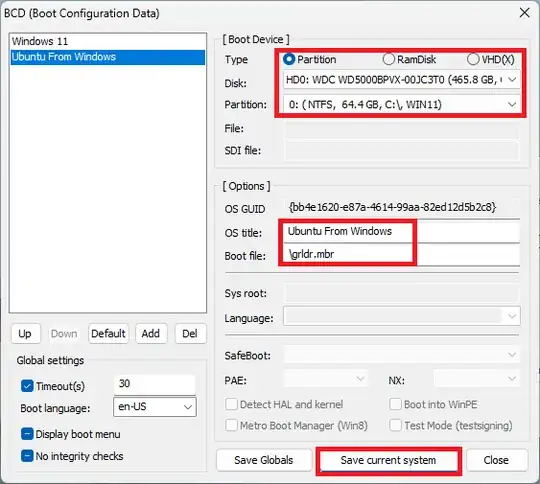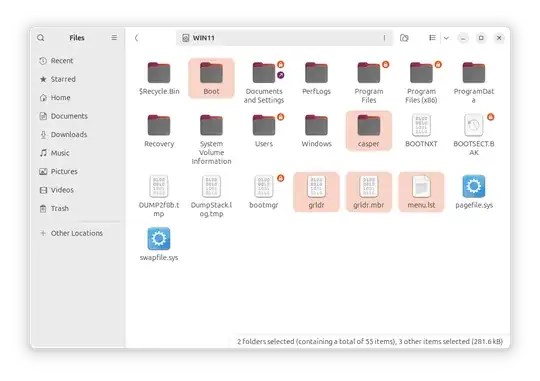Adding multi-Ubuntu boot entries to the Windows boot manager
1. Use Bootice.exe to add one entry to the BCD file.



2. Copy the /casper directory from the Ubuntu ISO file to the root of the Windows partition. If you want to install Ubuntu, copy all directories from the ISO file except the boot directory; don't copy the boot directory to the Windows partition.
3. Copy these files; grldr and grldr.mbr from the Easybcd directory to the root of the Windows partition. Bootice.exe and Easybcd.exe exist in HBCD_PE_64.iso and can be downloaded online.
4. Create a menu.lst file in the root of the Windows partition, and add the appropriate entries. this is an example:
timeout 5
default 0
title Ubuntu
kernel /boot/vmlinuz-6.8.0-40-generic root=/dev/sda3 ro --
initrd /boot/initrd.img-6.8.0-40-generic
title \n
root
title Ubuntu 24.04 Live System
kernel /casper/vmlinuz-noble boot=casper layerfs-path=minimal.squashfs --
initrd /casper/initrd-noble
title \n
root
title Ubuntu 22.04 Live System
kernel /casper/vmlinuz boot=casper layerfs-path=filesystem.squashfs --
initrd /casper/initrd.gz
In this example, three entries were added, one for the Ubuntu partition and two for live sessions. When you reboot and select Ubuntu, you will see all these entries in the submenu.
If you use more than one live session, rename the vmlinuz, initrd, and *.sguashfs files in the /casper directory and use the same names in the menu entry. If you want to install Ubuntu, don't rename the files, rename the live session files instead.
Now you can boot with one or more live sessions. To reach the Ubuntu partition, copy the vmlinuz and initrd files from the /boot directory in Ubuntu to the /boot directory in the Windows partition. Also, you can add more kernels.

Now you can use the live session to reinstall the grub bootloader or use boot-repair to solve the auto booting to Windows without the USB flash drive.
Update:
Menu entry to boot from Ubuntu ISO file:
title Boot ubuntu noble iso
set ISO=/noble-desktop-amd64.iso
find --set-root %ISO%
map %ISO% (0xff)
map --hook
root (0xff)
kernel /casper/vmlinuz boot=casper iso-scan/filename=/noble-desktop-amd64.iso --
initrd /casper/initrd
Menu entry to boot from Super Grub2 Disk ISO file:
title Boot Super Grub2 Disk
find --set-root --ignore-floppies --ignore-cd /super_grub2_disk_hybrid_2.04s1.iso
map --heads=0 --sectors-per-track=0 --mem /super_grub2_disk_hybrid_2.04s1.iso (hd32)
map --hook
root (hd32)
chainloader (hd32)
How to use Windows CMD to boot from the Ubuntu ISO file in the C partition without needing a USB flash drive or creating another partition
Create recovery partition to install, backup, restore and repair: multi Ubuntu versions, HBCD-PE-64 and multi Windows installation without usb drive
Boot to any payload (e.g. linux ISOs) directly from the Windows Boot Manager menu



